
USS Bonefish (SS-223) was a Gato-class submarine, the first United States Navy ship to be named for the bonefish.

USS Terry (DD-513), a Fletcher-class destroyer, was the second ship of the United States Navy to be named for Commander Edward A. Terry (1839–1882).

USS Emmons (DD-457/DMS-22) was a Gleaves-class destroyer of the United States Navy, named for Rear Admiral George F. Emmons (1811–1884).
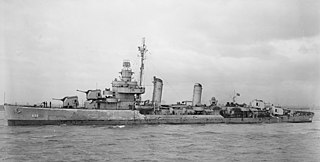
USS Knight (DD-633), a Gleaves-class destroyer, is the only ship of the United States Navy to be named for Admiral Austin M. Knight.

USS Rich (DE-695) was a Buckley-class destroyer escort, the first United States Navy ship named in honor of Lieutenant (j.g.) Ralph M. Rich (1916–1942) who was awarded the Navy Cross for his leadership as a fighter pilot off Enterprise during the Battle of Midway.
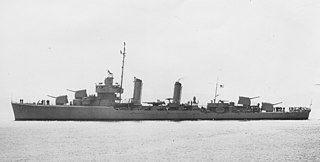
USS Carmick (DD-493/DMS-33), a Gleaves-class destroyer, was the only ship of the United States Navy to be named for Major Daniel Carmick (1772–1816), an officer in the United States Marine Corps who served during the Quasi-War with France and during the War of 1812.

USS Hobson (DD-464/DMS-26), a Gleaves-class destroyer, was the only ship of the United States Navy to be named for Richmond Pearson Hobson, who was awarded the Medal of Honor for actions during the Spanish–American War. He would later in his career attain the rank of rear admiral and go on to serve as a congressman from the state of Alabama.

USS Hall (DD-583) was a Fletcher-class destroyer of the United States Navy. Hall entered service in 1943 and deployed to the Pacific theater. Following the war, the ship was placed in reserve until 1959, when she was sold to the Hellenic Navy and renamed Lonchi. The destroyer remained in service with the Hellenic Navy until 1990 and was scrapped in 1997.

USS Jouett (DD-396) was a Somers-class destroyer in the United States Navy. She was named for Rear Admiral James Edward Jouett.

HMS Saumarez was an S-class destroyer of the Royal Navy, completed on 1 July 1943. As a flotilla leader, her standard displacement was 20 tons heavier than other ships of her class. She continued the tradition of flotilla leaders being named after prominent British seamen, in her case Vice-Admiral James Saumarez, 1st Baron de Saumarez of the late 18th and early 19th centuries.

HMS Safari was a third batch S-class submarine built for the Royal Navy during World War II. Commissioned in 1942, she was assigned to operate in the Mediterranean Sea. During the course of the war, Safari sank twenty-five ships, most of which were Italian.
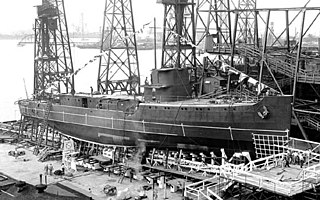
USS Auk (AM-57) was an Auk-class minesweeper acquired by the United States Navy for the dangerous task of removing mines from minefields laid in the water to prevent ships from passing.
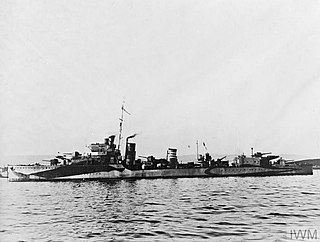
HMS Faulknor was the flotilla leader for the F-class destroyers built for the Royal Navy during the 1930s. The ship had a particularly active operational role during World War II, being awarded 11 battle honours, and was known as "The hardest worked destroyer in the Fleet". She was the first ship to sink a German U-boat, took part in the Norwegian Campaign, served with Force H in the Mediterranean on the Malta Convoys, escorted convoys to Russia and across the Atlantic, and saw action during the invasions of Sicily, Italy and Normandy, and was at the liberation of the Channel Islands. She was then decommissioned and sold for scrap in late 1945.

USS Staff (AM-114) was an Auk-class minesweeper acquired by the United States Navy for the dangerous task of removing mines from minefields laid in the water to prevent ships from passing.

USS Swerve (AM-121) was an Auk-class minesweeper acquired by the United States Navy for the dangerous task of removing mines from minefields laid in the water to prevent ships from passing.

USS Threat (AM-124) was an Auk-class minesweeper acquired by the United States Navy for the dangerous task of removing mines from minefields laid in the water to prevent ships from passing.

HMS Fury was an F-class destroyer built for the Royal Navy in the 1930s. Although assigned to the Home Fleet upon completion, the ship was attached to the Mediterranean Fleet in 1935–36 during the Abyssinia Crisis. During the Spanish Civil War of 1936–1939, she spent time in Spanish waters, enforcing the arms blockade imposed by Britain and France on both sides of the conflict. The ship escorted the larger ships of the fleet during the early stages of World War II and played a minor role in the Norwegian Campaign of 1940. Fury was sent to Gibraltar in mid-1940 and formed part of Force H where she participated in the attack on Mers-el-Kébir and the Battle of Dakar. The ship escorted numerous convoys to Malta in 1940–41 and Arctic convoys during 1942.

United States Navy operations during World War I began on April 6, 1917, after the formal declaration of war on the German Empire. The United States Navy focused on countering enemy U-boats in the Atlantic Ocean and the Mediterranean Sea while convoying men and supplies to France and Italy. Because of United States's late entry into the war, her capital ships never engaged the German fleet and few decisive submarine actions occurred.
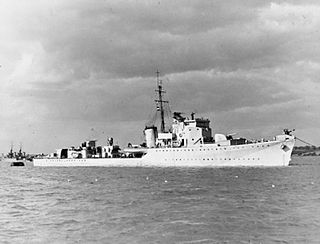
The second HMS Hambledon was a Hunt-class destroyer of the Royal Navy in commission from 1940 to 1945. She was a member of the first subgroup of the class, and saw service throughout World War II.

HMS Whitehall, pennant number D94, later I94, was a Modified W-class destroyer of the British Royal Navy that saw service in the Second World War.





















